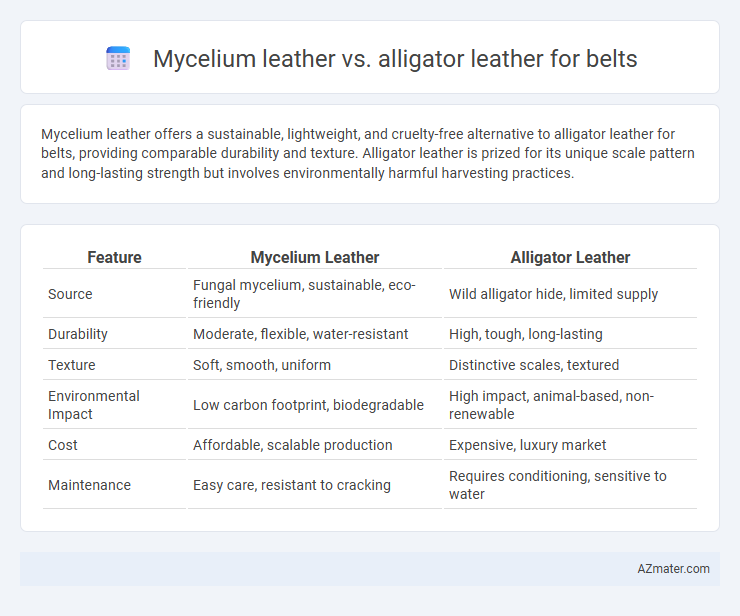Mycelium leather offers a sustainable, lightweight, and cruelty-free alternative to alligator leather for belts, providing comparable durability and texture. Alligator leather is prized for its unique scale pattern and long-lasting strength but involves environmentally harmful harvesting practices.
Table of Comparison
| Feature | Mycelium Leather | Alligator Leather |
|---|---|---|
| Source | Fungal mycelium, sustainable, eco-friendly | Wild alligator hide, limited supply |
| Durability | Moderate, flexible, water-resistant | High, tough, long-lasting |
| Texture | Soft, smooth, uniform | Distinctive scales, textured |
| Environmental Impact | Low carbon footprint, biodegradable | High impact, animal-based, non-renewable |
| Cost | Affordable, scalable production | Expensive, luxury market |
| Maintenance | Easy care, resistant to cracking | Requires conditioning, sensitive to water |
Introduction: Mycelium Leather vs Alligator Leather for Belts
Mycelium leather, derived from mushroom roots, offers a sustainable and cruelty-free alternative to traditional animal hides like alligator leather, which is prized for its unique texture and durability. The structure of mycelium leather provides a lightweight, flexible material that mimics the appearance of exotic leathers without the environmental impact associated with alligator farming. Choosing between mycelium and alligator leather for belts involves balancing eco-conscious innovation with the luxury and robustness characteristic of genuine alligator skin.
Material Origins: Fungi vs Animal Sources
Mycelium leather originates from the root structure of fungi, offering a sustainable and biodegradable alternative to traditional animal hides. Alligator leather is derived from the skin of alligators, an animal source known for its durability and distinctive texture but involves ethical and environmental concerns related to wildlife harvesting. The choice between mycelium leather and alligator leather for belts reflects a preference for innovative, eco-friendly materials versus classic, exotic animal products.
Production Process Comparison
Mycelium leather is produced through the cultivation of fungal mycelium, which grows rapidly on agricultural waste under controlled conditions, resulting in a sustainable and biodegradable material with minimal environmental impact. Alligator leather requires the harvesting and tanning of alligator hides, involving resource-intensive processes like chemical treatments, water usage, and long curing times that raise ethical and ecological concerns. Compared to alligator leather, mycelium leather offers a lower carbon footprint and a more eco-friendly production cycle, making it a compelling alternative for sustainable belt manufacturing.
Environmental Impact and Sustainability
Mycelium leather, derived from fungal roots, offers a highly sustainable alternative to alligator leather due to its rapid growth, minimal water usage, and lower carbon footprint. Alligator leather production involves habitat disruption, overfishing concerns, and significant resource consumption, contributing to environmental degradation. Choosing mycelium leather belts supports eco-friendly fashion with biodegradable properties and reduces reliance on endangered wildlife.
Durability and Longevity
Mycelium leather offers remarkable durability with natural resistance to wear and tear, making it an eco-friendly alternative to traditional materials. Alligator leather is renowned for its exceptional toughness and long-lasting quality, often improving in texture and patina over time. Both materials provide significant longevity, but alligator leather typically outperforms mycelium leather in terms of lifespan under heavy use.
Aesthetics and Style Variations
Mycelium leather offers a modern, eco-friendly alternative to alligator leather with a matte finish and customizable textures that appeal to contemporary fashion enthusiasts. Alligator leather stands out for its distinctive, natural scale patterns and glossy surface, embodying luxury and timeless elegance ideal for classic belt designs. Style variations in mycelium leather include a wide range of colors and finishes, while alligator leather belts typically highlight the rich, organic grain and polished sheen unique to each hide.
Comfort and Wearability
Mycelium leather offers exceptional breathability and flexibility, making it highly comfortable for belts worn throughout the day, while alligator leather is stiffer and may require a break-in period. The soft texture of mycelium leather reduces skin irritation and adapts well to wrist or waist movements, enhancing wearability. Alligator leather's durability is notable, but its rigidity can cause less comfort and restricted movement compared to the lightweight, sustainable properties of mycelium leather.
Ethical Considerations
Mycelium leather offers a sustainable and cruelty-free alternative to alligator leather by utilizing fast-growing fungal fibers that require minimal environmental resources and eliminate animal harm. Alligator leather production involves animal farming and hunting, raising concerns over wildlife conservation and ethical sourcing practices. Choosing mycelium leather for belts significantly reduces the ethical impact associated with exotic animal skin procurement while supporting innovative, eco-friendly materials.
Price and Market Accessibility
Mycelium leather offers a cost-effective and sustainable alternative to alligator leather, with prices significantly lower due to its lab-grown production process. Alligator leather remains a luxury material, commanding high prices and limited availability in niche markets. Market accessibility for mycelium leather is expanding rapidly as synthetic bio-leathers gain popularity, while alligator leather is restricted by ethical regulations and hunting quotas.
Future Trends in Leather Belt Alternatives
Mycelium leather offers a sustainable and biodegradable alternative to traditional alligator leather for belts, responding to increasing consumer demand for eco-friendly materials. Innovations in mycelium processing have enhanced durability and texture, making it a viable competitor to the luxurious but environmentally taxing alligator leather. As regulatory pressures and ethical concerns grow, mycelium leather is expected to dominate future trends in the premium leather belt market, combining luxury appeal with sustainable innovation.

Infographic: Mycelium leather vs Alligator leather for Belt
 azmater.com
azmater.com